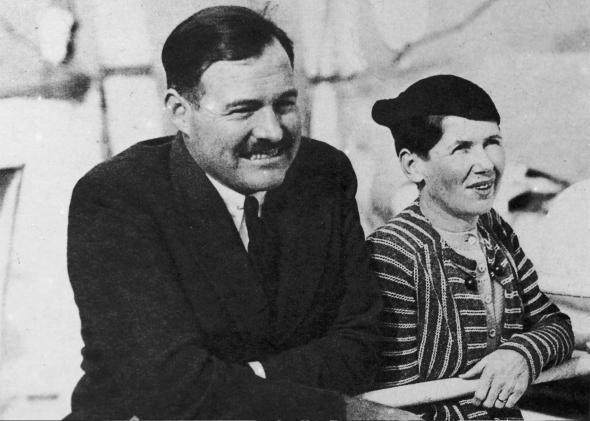But he did strike back at Hemingway in his memoir, Papa (1976), which expressed his sense of tragic betrayal and made a cruel judgment of the god that failed. I first interviewed Gregory in Bozeman, Montana, in May 1983. He had lost his medical practice in Jordan, in the eastern part of the state, and invited me to stay at his house. Ernest Hemingway's Memoir of Paris in the Twenties. By CHARLES POORE. A MOVEABLE FEAST. Sketches of the Author's Life in Paris in the Twenties. By Ernest Hemingway. Basically, it is a memoir, by the journalist A.E Hotchner, of his friendship with Ernest Hemingway, from the late 1940's to his death in 1961. The structure is very smartly done- each chapter is headed by not only a new year, but a new location, as Hotchner often traveled with Hemingway on his exotic adventures. The family memoirs by Leicester Hemingway, Marcelline Sanford, Madelaine Miller, and Mary Hemingway provide valuable information but show little understanding of the man. Gregory Hemingway’s memoir, though more intelligent, participates in the debunking process by paying off old scores and trying to lay some troubling ghosts of his own. First published in 1966, this adulatory memoir made news by revealing that Ernest Hemingway's 1961 death was a suicide. It also provided the mythmaking, Nobel Prize-winning author with an opportunity to promulgate his preferred public persona from beyond the grave.
Hemingway Memoir
May 5, 1964
Ernest Hemingway's Memoir of Paris in the TwentiesBy CHARLES POORE
| A MOVEABLE FEAST Sketches of the Author's Life in Paris in the Twenties. By Ernest Hemingway. Introduction by Mary Hemingway. |
he importance of beating Ernest, someone once said, gave a hopeless target to industrious lit'ry careerists. How cheerfully Hemingway was aware of that--and how early--appears quite clearly in this memoir of what I can only call his brilliantly obscure emergence as a man of letters. Here is Hemingway at his best. No one has ever written about Paris in the nineteen twenties as well as Hemingway. Thousands, of course, have given their own bright versions of that unaccountably perpetual springtime, but too many lost parts of their own identities in taking on some of Hemingway's. And they could not precisely share his astounding fugue of interests, which wove Tolstoy out of Sylvia Beach's bookship with days at the great race tracks, skiing expeditions to the Alps and the study of CÈzanne, noticing that F. Scott Fitzgerald was wearing a British Guardsman's tie and boxing with Ezra Pound, forays to Pamplona and living above a sawmill at 113 Rue Notre Dame des Champs.
It made a very movable feast. The feasting was sometimes pretty Spartan. Yet Hemingway and his first wife, Hadley Richardson, and their infant son, lived high on low amounts of money. Wages were precarious for a writer trying to get on paper, in his phrase, 'the sequence of motion and fact which made the emotion,' trying to create rather than describe.
And what was the upshot? What--as one of his friends of those days, Archibald MacLeish, asked--what became of him? And answered:
Hemingway Memoir Crossword
Fame became him. Veteran of the wars before he was twenty:Famous at twenty-five: thirty a master--Whittled a style for his time from a walnut stickIn a carpenter's loft in a street of that April city.

Fame was quick in coming, though in this book it seems elegiacally slow. And prosperity is far around the crooked corners of Montparnasse.
It would be a shallow mistake to take this book as a return only to the past. 'If the reader prefers,' Hemingway suggests at the end of a preface date a year or so before his death in 1961--'this book may be regarded as fiction. But there is always the chance that such a book of fiction may throw some light on what has been written as fact.'
There you have it. And the light these pages throw on what has been written by and around and about Hemingway is extraordinarily various. 'A Moveable Feast' decidedly would not have the tone of the twenties as he put it to his ear in the nineteen-fifties if Hemingway had not subsequently written the books that led to the Nobel Prize and read the things about himself that sometimes made him wonder whether he was a figment of his critics' odd imaginations.
The Society of Those Who Knew Hemingway When--a motley if there ever was one--is here in silhouette. But there are Goyesque portraits in full color of Pound and Gertrude Stein and Scott and Zelda Fitzgerald and James Joyce. It would be unkind to ask the forever undemobilized pallbearers of Ford Madox Ford to cheer Hemingway's view of Ford-double-Ford. However, several writers who may have fattened their portfolios by remembering that they knew him rather more extensively then he remembered having known them will probably be content to remain incognito at 'A Moveable Feast.'

Any book by or about Hemingway suddenly becomes the occasion for another full-scale review of his career and I don't think this one is going to prove a conspicuous exception. The St. Vitus dancers among his critics who are mazily on record for changing their minds about him are always good for one more swing. But, once again, it is a greater pleasure, for the reader at large, to read Hemingway than to cope with the folklorist of his mythology.

